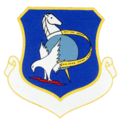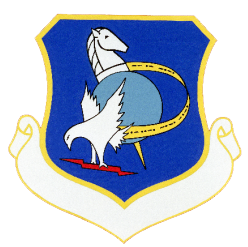File:1998th Communications Group emblem.png
1998th_Communications_Group_emblem.png (248 × 247 pixels, file size: 88 KB, MIME type: image/png)
Captions
Captions
Summary[edit]
| Description1998th Communications Group emblem.png |
English: Emblem of the 1998th Communications Group, Airlift Communications Division part of the United States Air Force. |
| Date | |
| Source | 1998th Communications Group lineage and history from usafunithistory.com |
| Author | United States Air Force |
Blazon[edit]
The ultramarine blue background identifies the aerospace theater of air traffic operations and communications. The globe indicates the worldwide nature of the unit's contingency communications mission, the command and control communications, and the strategic airlift emanating via the air traffic and air navigation services. Favored chess piece among players, the knight, is in direct service to the king, upholding the kingdom and renowned for flexibility. This represents the service role of air traffic control to Air Force air operations and the many ways in which those operations are supported. It also indicates the variety of communications devices available to commanders to control and organize their commands, even over great distances; communications makes flexible response possible. The falcon is the symbol for flight and service, identifying the unit's air operations mission and the Air Force flight mission. For ages falcons have served kings and are known for highspeed flight; the falcon represents quick response afforded by air traffic and communications services. The yellow band encircling the globe, demonstrates fluidity and motion. It depicts the dynamic communications mission and shows the connectivity in the knight's service with air operations. The band in Morse code (a classic communications method still used to identify air navigational aids) shows command relationships. The lightning bolt is used to identify the power of rapid electronic communications in the hands of Air Force meteorological element (significant because of unit support of meteorological measurement systems). The pinnacle at the base of the globe is a stylized antenna to identify the variety of transmission systems employed by the unit. Ground-to-air UHF/VHF aircraft control radios, intrabase radio systems, satellite communications and military affiliate high frequency radio systems are operated and maintained to provide voice command-and-control communications in support of day-to-day, emergency, and contingency operations.
Licensing[edit]
| Public domainPublic domainfalsefalse |
This image or file is a work of a U.S. Air Force Airman or employee, taken or made as part of that person's official duties. As a work of the U.S. federal government, the image or file is in the public domain in the United States.
العربية ∙ беларуская (тарашкевіца) ∙ català ∙ čeština ∙ Deutsch ∙ English ∙ español ∙ eesti ∙ فارسی ∙ suomi ∙ français ∙ italiano ∙ 日本語 ∙ 한국어 ∙ македонски ∙ മലയാളം ∙ မြန်မာဘာသာ ∙ norsk bokmål ∙ Plattdüütsch ∙ Nederlands ∙ polski ∙ português ∙ português do Brasil ∙ русский ∙ sicilianu ∙ slovenčina ∙ slovenščina ∙ српски / srpski ∙ svenska ∙ Türkçe ∙ українська ∙ Tiếng Việt ∙ 中文(简体) ∙ 中文(繁體) ∙ +/− |
 |
File history
Click on a date/time to view the file as it appeared at that time.
| Date/Time | Thumbnail | Dimensions | User | Comment | |
|---|---|---|---|---|---|
| current | 13:11, 3 October 2023 |  | 248 × 247 (88 KB) | Coldstreamer20 (talk | contribs) | Uploaded a work by United States Air Force from [https://usafunithistory.com/PDF/1000/1998%20COMMUNICATIONS%20GP.pdf 1998th Communications Group lineage and history] from usafunithistory.com with UploadWizard |
You cannot overwrite this file.
File usage on Commons
The following page uses this file:
Metadata
This file contains additional information such as Exif metadata which may have been added by the digital camera, scanner, or software program used to create or digitize it. If the file has been modified from its original state, some details such as the timestamp may not fully reflect those of the original file. The timestamp is only as accurate as the clock in the camera, and it may be completely wrong.
| Software used | Adobe Photoshop 21.2 (Windows) |
|---|---|
| Date and time of digitizing | 05:09, 3 October 2023 |
| Date metadata was last modified | 05:09, 3 October 2023 |
| File change date and time | 05:09, 3 October 2023 |
| Unique ID of original document | xmp.did:a3ac6957-3f2d-8d4c-8aff-f438bb4271ce |
| Horizontal resolution | 28.35 dpc |
| Vertical resolution | 28.35 dpc |
